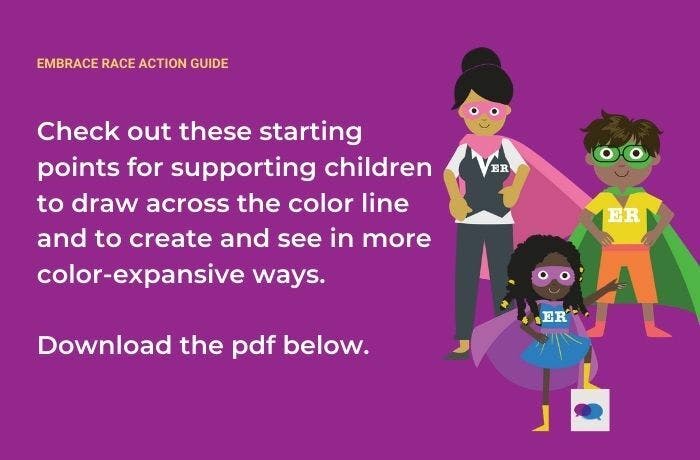Tips for Drawing Across Color Lines with Kids

If drawing someone is a metaphor for, and a means to, truly seeing and honoring that person, then we must support all children to depict Black and Indigenous people and people of color (BIPOC) characters as readily as they do White characters. With the Drawing Across the Color Line with Kids project, we hope to inspire more caregivers and children to create and see in more color-expansive ways.
What follows are tips we’ve developed from this work for supporting kids to draw kids of color, too. Big thanks to children’s book authors/illustrators Grace Lin, Oge Mora and Yuyi Morales for their insights! (Check out our conversation with them here: Drawing Across the Color Line with Kids.)
1. Help kids develop the vocabulary to describe physical differences among people in the world and in their artwork.
- Helping kids describe a range of skin colors, hair textures, facial features and other differences gives them tools for talking about their lives and art and supports them to see and value difference.
2. Start with tools that allow children to represent a range of skin-tone colors.
- There are fantastic skin color crayons and markers available that give kids more choices than the White, Peach, Orange, Brown and Black crayons of old. Using different color papers and paints is also an option. Experiment with NOT starting with white paper. When Yuyi Morales drew Grace Lin for this project, she drew on a brown paper bag.
3. Help all kids connect to and spotlight the stories of Black and Indigenous people and communities of color.
- As Oge Mora put it, “It’s not enough just that those stories are there, but how are we connecting those stories to kids?” One way to connect stories with them is to “lift up” and read the pictures and images that feature BIPOC people and communities, not just the text or dialogue. Kids are very observational and will have a lot to say about what they’re seeing.
4. Spotlighting BIPOC people and communities in their drawings will require different moves for different children and families.
- BIPOC kids and families can start by drawing each other, drawing community members and/or creating self-portraits.
- White kids and families can choose friends of different races and ethnicities and have a drawing session by video or using photographs.
- BIPOC kids and families can spend time drawing BIPOC friends across the racial and ethnic spectrum by video chat or using photographs.
- Families can spend time drawing diverse images from books or drawing strangers, historical figures, and people in their communities.
5. Create a safe, nonjudgmental space for kids to draw.
- Yuyi Morales calls it a space where “you’re not going to be criticized... It should be a place where anything that happens at that moment on the paper, on the wall, whatever it is being done, is valid and it doesn’t have to be corrected.”
- Don’t expect kids to be completely representational. If they paint a friend with green skin or scribbles, it doesn’t mean they’re not seeing their friend, it means it’s not a direct translation.
- Resist telling them their drawing is good. Instead, ask them about their choices of subjects, colors, shapes, textures, and so on.
- Drawing someone you know is special, but some kids will feel more pressure if they have to share the drawing. Don’t make that a requirement.
Draw with your kids!
Drawing along side kids is the strongest encouragement you could give. And you’ll likely learn a lot, too! It’s a journey. If you or your child is uncomfortable drawing themselves or others, remember that your comfort and skills will grow.
Are you ready?
Tag @EmbraceRace on Instagram with the portraits you and the kids in your life draw.
Get Insights In your Inbox
Join the EmbraceRace community! You will receive the newsletter with our latest on race & kids, including upcoming events and opportunities, resources, community news and curated links.
Subscribe


